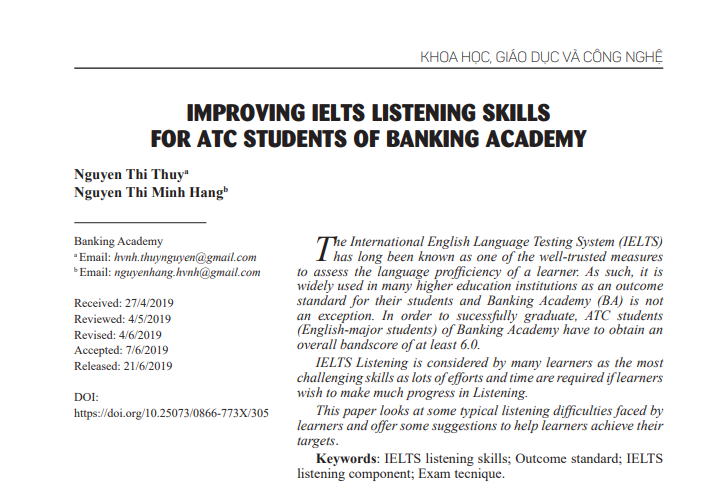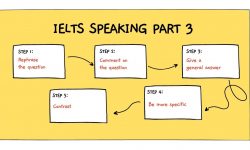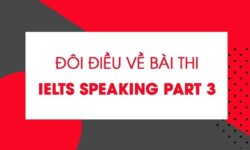IELTS listening skills for ATC student of banking academy

FOR ATC STUDENTS OF BANKING ACADEMY
1. Listening perspectives
1.1. Listening definitions
Howatt and Dakin (1974) believe that listening refers to the ability of a person to identify and understand what others are saying and this is a procedure which requires the listener to be able to understand of the accent, pronunciation, grammar and vocabulary as well as comprehend the message delivered. And therefore a good listener is defined as the one who is capbable of doing these four things
simultenously.
Thomlison’s (1984) definition of listening includes “active listening”, which goes beyond comprehending as understanfing the message content, to comprehension as an act of empathetic understanding of the speaker.
According to Hamouda (2013), listening comprehension is the ability to understand what the listener has been heard and repeat the text despite the fact that the listener may repeat the sounds without real comprehension.
Xem thêm:
- Ebook Writing IELTS Miễn Phí
- Tải sách Cambridge Grammar for IELTS PDF miễn phí
- BÍ KÍP TỰ HỌC IELTS TỪ CON SỐ 0 LÊN 8.0
- Cambridge IELTS 3
1.2. Types of listening
According to Johna Kline (1996) there are five types of Listening
1.2.1. Informative listening
Informative listening refers to the situation where the utmost goal of the listener is to get the message delivered. This type of listening is found in all areas of our lives and much of our learning comes from informative listening. There are three key factors to help listeners be successful in understanding what the speaker means: vocabulary, concentration and memory.
1.2.2. Relationship listening
The purpose of relationship listening is either to help an individual or to improve the relationship between people. Therapeutic listening is a special type of relationship listening. Therapeutic listening brings to mind situations where counselors, medical personnel, or other professionals allow a troubled person to talk through a problem. Although relationship listening requires listeners to listen for information, the emphasis is on understanding the other person. Three behaviors are key to effective relationship listening: attending, supporting, and empathizing.
1.2.3. Appreciative listening
Appreciative listening refers to the situation when listeners listen for enjoyment, for example: listening to music or listening and watching films. As such, the focus is the response of the listener, not the information or the message and the effect of appreciative listening will not be the same for every listener. The quality of appreciative listening largely depends on three factors: presentation, per-ception, and previous experience.
1.2.4. Critical listening
Critical listening requires the listener to make judgement or response to the message they receive. In order to be an effective critical listener, one should be able to analyse the three elements of the message: ethos, or source credibility; logos, or logical argument; and pathos, or psychological appeals.
1.2.5. Discriminative listening
The final type of listening is also the most important one as it acts as a basis for the other four types. The focus of discriminative listening is on sounds and sound structures to get the true and intended meaning of the message.
2. Listening matters concerning IELTS listening tests
Xem thêm:
- Bật mí Tăng Kỹ Năng Nghe – Listening Trong IELTS cực hiệu quả
- IELTS Reading and Some techniques to improve IELTS Reading skills for students
- Học tủ dạng bài điền từ cho Section 1 – IELT Listening
- Download IELTS for academic purpose fap book miễn phí [PDF]
- Download trọn bộ Basic IELTS Listening, Speaking, Reading, Writing (PDF + Audio)
2.1. Listening in IELTS
2.1.1. Purpose of the test
The IELTS Listening test is designed to assess a variety of listening skills. In particular, it is to check how well listeners get main ideas and specific detailed information, how well they recognise the opinions, attitude and purpose of a speaker and to check if they can follow the development of argument.
2.1.2. How the IELTS Listening component is organized.
It consists of four sections and there are usually two conversations and two monologues set in everyday social matters, e.g. a conversation in a bank, in an accommodation agency, among students and subjects relates to educational and training situations. The recordings are played once only and the test approximately lasts 30 minutes.
There are a variety of question types including multiple choice questions, matching, short answer questions, sentence completion, form/table completion, labeling a map/diagram/plan, summary, and classification of information.
2.1.3. IELTS Listening exam techniques
- Predict answer types before listening: Students should be able to anticipate the type of information required because when they are aware of what they have to listen for, they have a good chance of getting correct answers and this process is known as “targeted listening”.
- Identify paraphrases and synonyms: English speakers are well known for using paraphrases and synonyms more often than speakers of many other languages, as such in the IELTS Listening test, the speakers normally use a synonym or a paraphrase of the keywords found in the question. Students should therefore practice thinking about how words seen in the question might be replaced by different words that convey the same or very similar meaning in the recordings.
- Improve pronunciation: According to Chastain (1988), one of the four components of listening comprehension is the ability to recognize all
sounds, intonation patterns, and voice qualities in the second language. In order to obtain success in IELTS Listening, students are advised to pay more attention to their pronunciation skills. - Grammar: Proper English grammar is definitely important for students to get a high Listening score. This is especially helpful in sentence and summary completion question types where an answer which is not only spelled correctly but also fitted grammatically is needed. Good grammar helps guide students towards correct answers.
Xem thêm:
- The effectiveness of Task – Based – Language teaching in improving IELTS Reading skill
- Từ vựng theo 22 chủ đề khác nhau trong IELTS Speaking
- IELTS topic vocabulary: Business and Money
- Tổng hợp đề IELTS Writing
2.2. Suggested in-class activities to enhance
students’ IELTS Listening skills.
2.2.1. Pre-listening activities
The purposes of the pre-listening activities are to provide students with a clear context of what they are going to hear and to equip students with the topic vocabulary as well as the language structures in the recordings.
- Brainstorming topic words: Teachers can give students the topic of the listening and ask them to write down the words that they think might appear in the listening. Teachers can then check, provide more related words if necessary. This activity is to enhance students’ topic vocabulary and to help them be more confident while listening.
- Running dictation: Have students arrange in lines. The first student of each line will be the runner. The runner goes to the wall and pick up a note where there is a chunk of text (extracted from the listening), memorizes it and runs back to the line and dictates it to the first member of the line.
- This member is then responsible for whispering the chunk of text to the next member of the line and this process goes on until the last member of the line receives the message and writes it down. The winner is the group which has the most correct words within the time given. The purposes of this activity are again to provide students with the topic of the listening and to check their pronunciation of the topic words.
- Expressing me: Give each student several words or expressions related to the theme of the listening text and ask them to explain the words/ expressions without mentioning the original words/ expressions to their partners. The partners will then have to guess the words/expressions. The aim of this activity is to focus on the importance of synonyms and paraphrases.
2.2.2. While –listening activities
Apart from the well-designed IELTS Listening practice tests that teachers can use in class, they can use other authentic materials and these activities to raise students’ interest in listening and to improve skills necessary for the IELTS Listening test such as: listening for the gist, listening for specific information and listening for speakers’ attitude or opinion.
A gapped text: Teachers could give students a copy of a song lyrics with certain words blanked out. The first option is to let students predict the words that go into each blank. The second option is to give them suggested words and they then have to analyze the text in order to fill in the correct words. The third option is to give them synonyms/ paraphrases of the words needed for each blank and
they need to find out the correct words. Once they have done this, they listen to the song and check their answers.
True/False statements: In this activity, students are required to watch a video clip and then determine whether the statements given are correct or not. It may be helpful if students underline keywords before they watch. Teachers could make use of videos (documentaries, news, weather forecast, interviews or inspiring speeches of famous people) available on the Internet to design the task. By using videos in their lessons, teachers can help students to retain more information, understand different concepts quicker and to make students
more interested in what they are listening to.
Right words: Students are required to find mistakes in a song lyric or a video script. This activity focuses on the words that often make
students confuse when they listen like homophones (words that have the same pronunciation but different meanings or spelling or similar soundwords.
2.2.3. Post-listening activities
A post-listening activity act as a follow up to the main listening activity and aims to utilize the knowledge or vocabulary obtained from the
listening.
- Summarizing: One of the activities that a teacher can do to check understanding is to ask students to summarize the information they have heard. This works best if the listening text is a story.
- Continuing the word lists: This can be seen as a follow up task of the brainstorming topic words in the pre-listening phase. In this task, students are asked to extend the word list with the word sets they have learnt from the main listening task
- Discussions: Teachers can ask students to have a short discussion about the topic taken from the main listening task.
3. Conclusion
In this paper, the authors have looked into theextent of IELTS Listening description, listening skill requirements and then give some suggestedin-class activities for teachers to perform well in listening class in order to enable their students toget the highest possible score in the test. Through this paper, the researcher believed that successful listening can only be acquired overtime and with continuous practice and teachers, with suitable teaching styles and teaching activities, can help students gradually become more confident in communication in general and in the IELTS listening component in particular.
Tải và xem tài liệu gốc Improving IELTS listening skills for ATC students of Banking Academy tại đây nhé: Download tài liệu








Bình luận